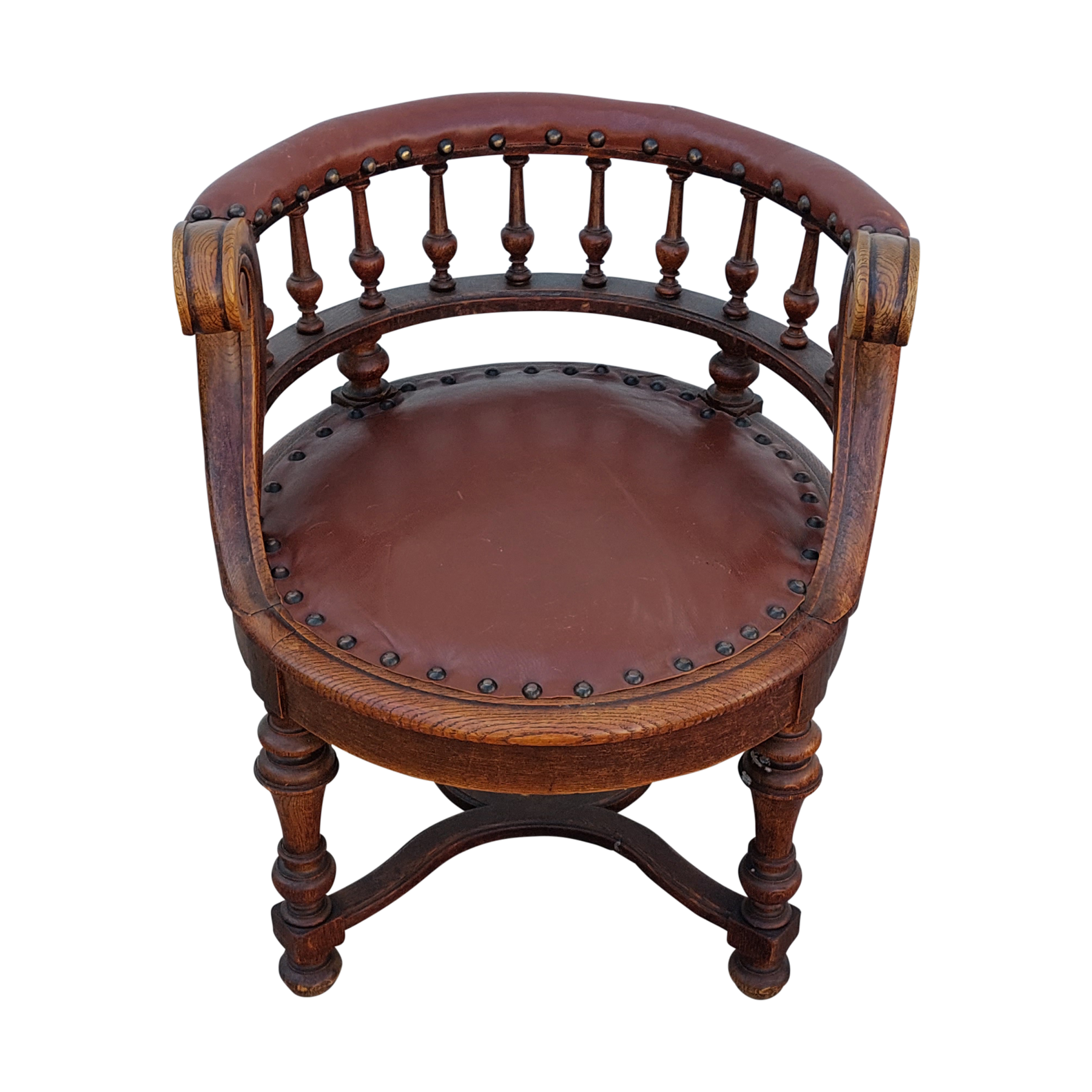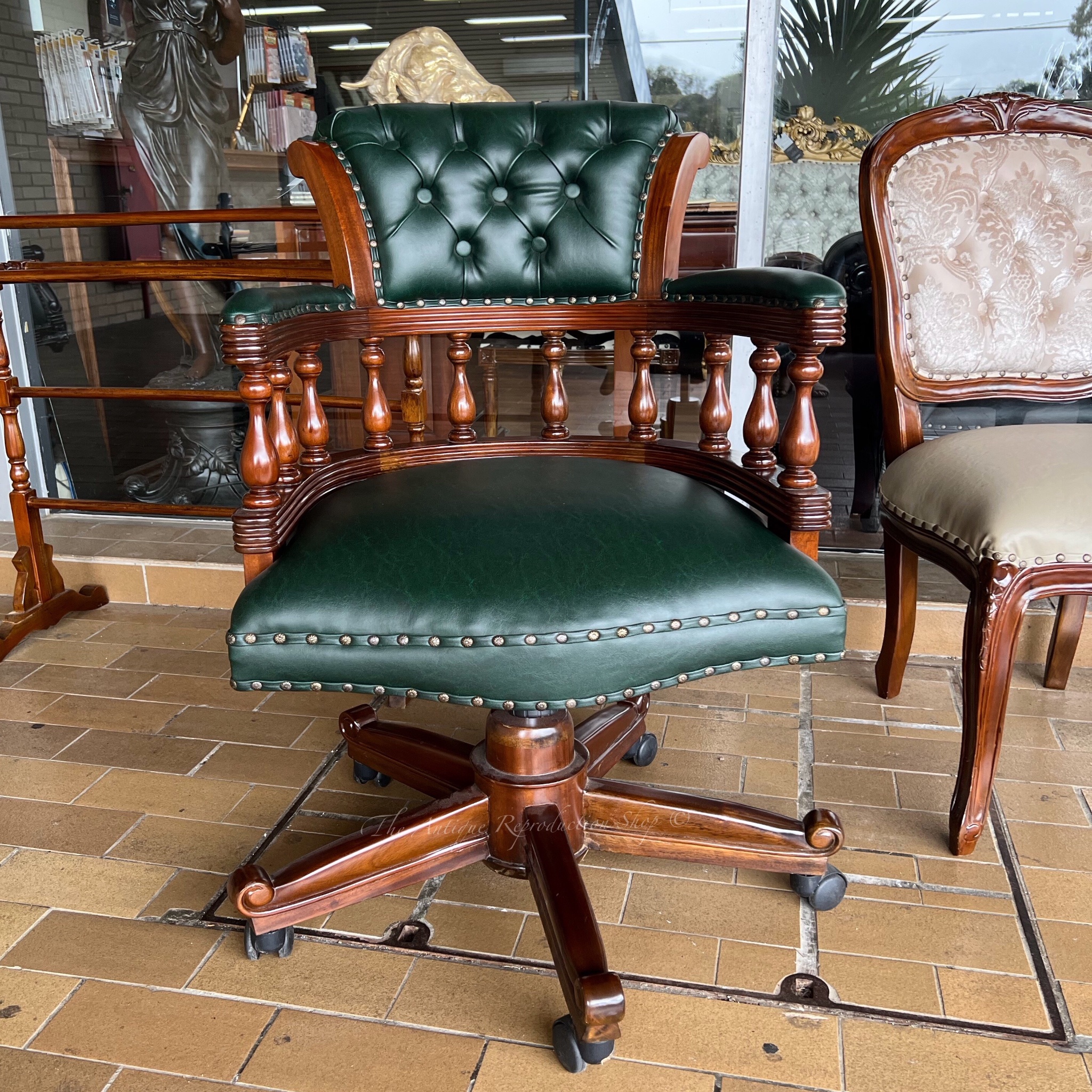Historical Context of Yew Wood Desks and Captain’s Chairs

Yew wood, prized for its durability and rich color, has played a significant role in the creation of both desks and captain’s chairs throughout history. These pieces, often handcrafted with meticulous attention to detail, reflect the evolving styles and craftsmanship techniques of different eras, providing a fascinating glimpse into the past. Their use spanned diverse settings, from the captain’s quarters of a sailing vessel to the study of a wealthy landowner.
Prevalence of Yew Wood Desks and Captain’s Chairs Across Historical Periods
Yew wood desks and captain’s chairs enjoyed periods of particular popularity coinciding with the availability of the wood and evolving design preferences. While precise dating for every piece is difficult, we can observe trends. For example, the sturdy nature of yew made it ideal for shipboard furniture during the Age of Sail (roughly 16th-19th centuries). Captain’s chairs, often featuring a high back and sturdy construction, were common in the captain’s cabin, providing a comfortable and practical seat for long voyages. Similarly, yew desks, known for their resilience, were favored in both domestic and office settings, particularly during the 17th and 18th centuries, when the wood’s dark, rich tone was in vogue. The rise of colonial styles further influenced the design and use of these pieces.
Craftsmanship Techniques in Different Eras, Yew desk and captain’s chair
The craftsmanship involved in creating yew wood desks and captain’s chairs varied across different historical periods. Early examples often featured simpler joinery techniques, relying on strong mortise and tenon joints to hold the pieces together. As techniques advanced, more intricate joinery, such as dovetail joints and complex frame-and-panel construction, became common. Wood finishing also evolved. Early pieces might have received a simple oil finish to protect the wood, while later examples showcase more elaborate techniques, including polishing and the application of various stains and varnishes to enhance the color and sheen of the yew. Ornamentation also varied widely. Simpler pieces might feature minimal carving or inlay, while more elaborate examples boast intricate carvings, marquetry, and the incorporation of other materials such as brass or bone.
Comparative Analysis of Design Features Across Historical Periods
The following table compares and contrasts the design features of yew wood desks and captain’s chairs from various historical periods.
| Period | Desk Features | Chair Features | Notable Differences |
|---|---|---|---|
| 17th Century | Simple, often rectangular; minimal ornamentation; sturdy construction; drawers may be present, but often less complex. | High-backed, sturdy construction; simple turned legs; often plain upholstery or leather. | Desks were more likely to be found in writing rooms or studies, while chairs were more versatile in use. |
| 18th Century | More elaborate designs; increased use of inlay and carving; incorporation of more drawers and compartments; bureau designs emerge. | More ornate carving; wider variety of upholstery styles; more decorative legs; emergence of styles reflecting regional preferences (e.g., Queen Anne, Chippendale). | Desks reflect increasing levels of personal adornment and storage needs, chairs reflect evolving styles and increased comfort considerations. |
| 19th Century | Styles vary widely, reflecting neoclassical, Regency, and Victorian influences; increased use of veneers; more elaborate hardware. | Styles vary widely to match the desks’ styles; wider use of different materials in upholstery; focus on comfort and grandeur. | Both desks and chairs reflect a wider range of tastes and the increasing availability of different materials and manufacturing techniques. |
Design Elements and Aesthetics: Yew Desk And Captain’s Chair

Yew wood desks and captain’s chairs, prized for their durability and rich aesthetic qualities, share a number of common design elements that have evolved over centuries. Understanding these elements reveals the craftsmanship and artistic sensibilities of different eras. The interplay of wood grain, hardware choices, and overall stylistic approach contribute significantly to the unique character of each piece.
The characteristic design elements of yew wood desks and captain’s chairs are deeply intertwined with the properties of the yew wood itself and the prevailing design trends of the period in which they were crafted. The inherent beauty of the wood, often featuring rich, deep brown tones with striking variations in grain pattern, forms the foundation of the aesthetic appeal. These pieces often showcase the wood’s natural beauty through minimal ornamentation, allowing the grain to be the focal point.
Wood Grain and Color
Yew wood possesses a distinctive character. Its color ranges from a light, almost golden brown to a deep, reddish-brown, often with darker streaks and knots adding visual interest. The grain itself can vary significantly, from fine and even to more pronounced and dramatic patterns, depending on the age and origin of the tree. The rich color and intricate grain patterns are often highlighted by finishes that enhance the natural luster of the wood, sometimes with a slight sheen, sometimes with a more matte appearance. The beauty of the wood itself often dictates the level of ornamentation, with simpler designs allowing the wood’s inherent elegance to shine.
Hardware and Ornamentation
The hardware used on yew wood desks and captain’s chairs often reflects the period of manufacture. Earlier pieces might feature simple, hand-forged iron hinges and latches, often with a dark, almost black finish. Later pieces may incorporate more ornate brass or even silver hardware, reflecting a shift towards more elaborate detailing. Ornamentation, while often subtle, can include carved details, inlay work, or marquetry, depending on the style and the maker’s skill. These details can range from simple geometric patterns to more complex floral or even figurative motifs.
Evolution of Design Styles
The design of yew wood desks and captain’s chairs has evolved considerably throughout history. Early pieces, often dating back to the 17th and 18th centuries, were typically characterized by a simpler, more functional design. These pieces tended to be sturdy and utilitarian, with a focus on practicality rather than elaborate ornamentation. Later pieces, particularly those from the Victorian era, often incorporated more elaborate carvings, inlays, and richer finishes. The size and shape of these pieces also varied across periods, with some pieces being quite compact and others significantly larger and more imposing. For example, a 17th-century writing desk might be relatively small and compact, while a Victorian writing desk could be significantly larger and more elaborate, incorporating features such as multiple drawers and a fall-front design.
Visual Description of a Typical Example
Imagine a yew wood writing desk, approximately 48 inches wide, 24 inches deep, and 30 inches high. The wood is a rich, dark brown, almost mahogany-like in its hue, with lighter streaks running through it, creating a beautiful and varied grain pattern. The desk features two large drawers with simple brass pulls, and a slightly raised writing surface. The finish is a satin sheen, allowing the wood grain to be clearly visible. Accompanying this desk is a captain’s chair, approximately 40 inches high with a seat height of 18 inches. The chair is constructed from the same rich yew wood, with a slightly curved back and gently tapered legs. The seat is upholstered in a deep green leather, its worn texture suggesting years of comfortable use. The leather is a slightly distressed, but well-maintained, showing its age gracefully. The chair’s overall proportions are balanced and comfortable, reflecting the careful craftsmanship of its maker.
Materials and Craftsmanship

Yew wood, with its remarkable properties and historical significance, has played a crucial role in the creation of enduring desks and captain’s chairs. Understanding the material’s characteristics and the craftsmanship involved in constructing these pieces provides insight into their lasting appeal and value.
The exceptional durability and aesthetic qualities of yew wood are central to its suitability for furniture making. Its dense, close-grained structure makes it incredibly resistant to wear and tear, capable of withstanding the rigors of daily use for centuries. Furthermore, yew’s rich color, ranging from a pale yellow to a deep reddish-brown, often punctuated by striking grain patterns, offers a unique visual appeal that has captivated artisans and furniture enthusiasts alike. The wood’s ability to accept a high polish further enhances its beauty, contributing to the refined look of fine furniture.
Comparison of Historical and Modern Craftsmanship
Historically, yew wood furniture was crafted using traditional techniques passed down through generations of skilled artisans. These craftsmen employed hand tools, such as chisels, planes, and saws, to meticulously shape and join the wood. Mortise and tenon joints, dovetail joints, and other intricate joinery methods were commonly used to create strong, durable pieces. The focus was on precision and quality, resulting in furniture that was not only functional but also a testament to the artisan’s skill. In contrast, modern reproductions often utilize power tools and mass-production techniques. While this allows for faster and potentially cheaper production, it can sometimes compromise the level of detail and the overall quality of the joinery found in historical pieces. The use of modern adhesives and finishes can also differ significantly from the traditional methods employed in the past. The availability of yew wood itself may also be a factor; the sustainability concerns surrounding the use of yew mean modern pieces might use less of the wood, or substitute it with other materials altogether.
Creating a Simple Yew Wood Desk or Captain’s Chair: A Step-by-Step Guide
Constructing a piece of yew furniture requires careful planning and precise execution. The following steps Artikel a simplified approach, focusing on key joinery techniques. Remember that this is a simplified guide and requires prior woodworking experience and appropriate safety precautions.
- Design and Planning: Create detailed drawings and plans for the desk or chair, specifying dimensions and joinery details.
- Material Selection and Preparation: Select high-quality, well-seasoned yew wood planks. Plane the planks to the required thickness and width, ensuring smooth, even surfaces.
- Cutting and Shaping: Cut the wood to the specified dimensions using hand saws or power tools. Shape the components using chisels, planes, and rasps, paying close attention to detail.
- Joinery: Utilize traditional joinery techniques such as mortise and tenon joints or dovetail joints to assemble the frame. Ensure precise cuts and tight fits for strength and stability. Dry-fitting before gluing is crucial.
- Assembly: Carefully assemble the components, using wood glue and clamps to secure the joints. Allow ample time for the glue to cure completely.
- Finishing: Sand the surface smooth using progressively finer grades of sandpaper. Apply a suitable finish, such as oil or varnish, to protect the wood and enhance its natural beauty. Multiple coats may be necessary.
